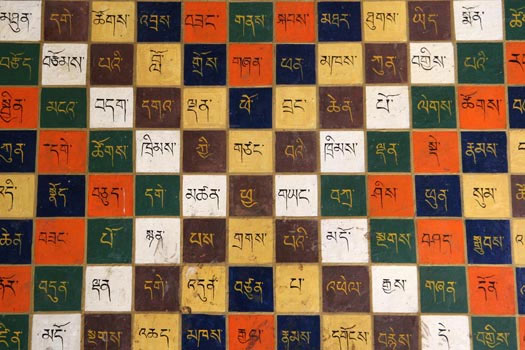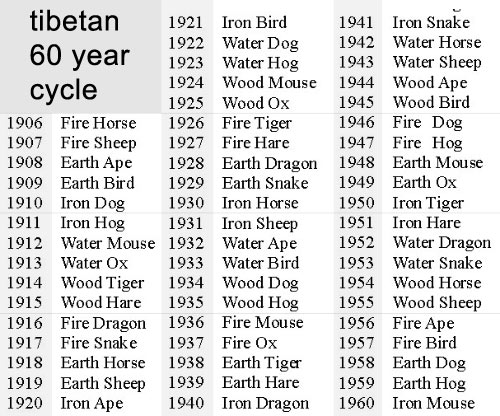The Tibetan calendar is a lunisolar calendar, that is, the Tibetan year is composed of either 12 or 13 lunar months, each beginning and ending with a new moon. A thirteenth month is added approximately every three years, so that an average Tibetan year is equal to the solar year. The months have no names, but are referred to by their numbers.
The Tibetan New Year celebration is Losar.
Each year is associated with an animal and an element. This is similar to the Chinese zodiac. The animals alternate in the following order: Hare, Dragon, Snake, Horse, Sheep, Ape, Bird, Dog, Pig, Mouse, Bull, Tiger.
The elements alternate in the following order: Fire, Earth, Iron, Water, Wood
Each element is associated with two consecutive years, first in its male aspect, then in its female aspect. For example, a male Earth-Dragon year is followed by a female Earth-Snake year, then by a male Iron-Horse year. The sex may be omitted, as it can be inferred from the animal.
The element-animal designations recur in cycles of 60 years(Sexagenary cycle), starting with a (female) Fire-Hare year. These big cycles are numbered. The first cycle started in 1027. Therefore, 2005 roughly corresponds to the (female) Wood-Bird year of the 17th cycle.

Weekdays
| Day | Tibetan (Wylie) | transcription | Planet |
|---|---|---|---|
| Sunday | གཟའ་ཉི་མ་ (gza' nyi ma) | Sa nyi-ma | Sun |
| Monday | གཟའ་ཟླ་བ་ (gza' zla ba) | Sa da-wa | Moon |
| Tuesday | གཟའ་མིག་དམར་ (gza' mig dmar) | Sa Mik-mar | Mars |
| Wednesday | གཟའ་ལྷག་པ་ (gza' lhag pa) | Sa Lhak-ba | Mercury |
| Thursday | གཟའ་ཕུར་པུ་ (gza' phur bu) | Sa Phur-bu | Jupiter |
| Friday | གཟའ་པ་སངས་ (gza' pa sangs) | Sa Ba-sang | Venus |
| Saturday | གཟའ་སྤེན་པ་ (gza' spen pa) | Sa ben-ba | Saturn |
The days of the week are named for celestial bodies. Nyima, Dawa and Lhagpa are common personal names for people born on Sunday, Monday or Wednesday respectively.

History
In the 7th century, Princess Wencheng brought Tang Dynasty's calendar to Tibet. Later Princess Jincheng (Tibetan: Kyimshang Kongjo) did the same thing. However, after the down fall of the Tubo Dynasty, Tibet became chaotic, and the transmissions of the Han Chinese calendars stopped.
Around 9th century, Islam expanded to India and many Indian Buddhists escaped to Tibet bringing with them concepts from Indian Astronomy. Tibetans integrated the Indian Astronomy and the Han calendars (rgya-rtsis) to form their own calendars. Later they adopted more from the Han calendars to form the present Tibetan calendars, which started from year 1027.
